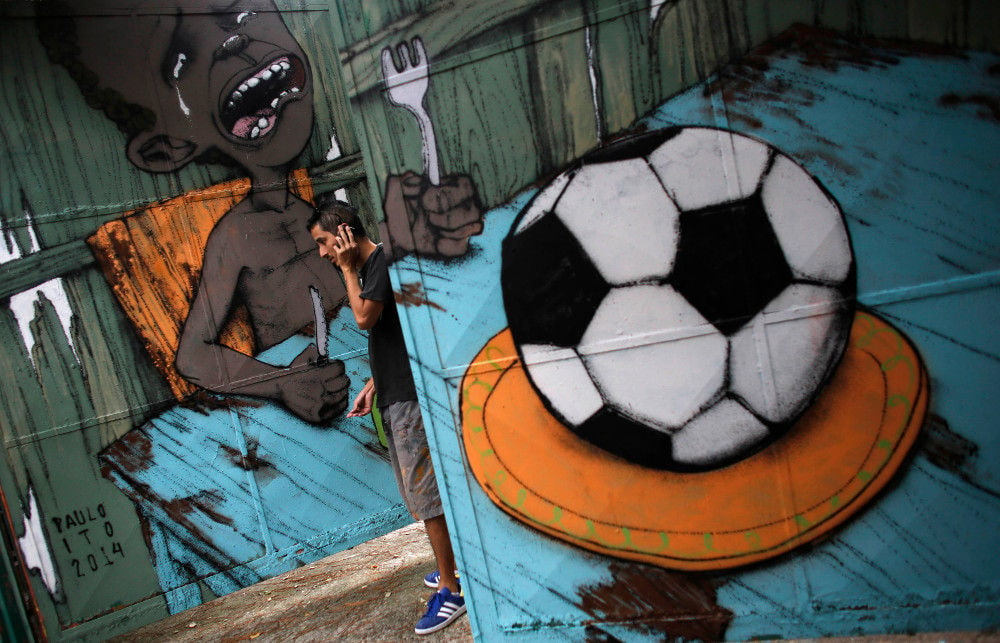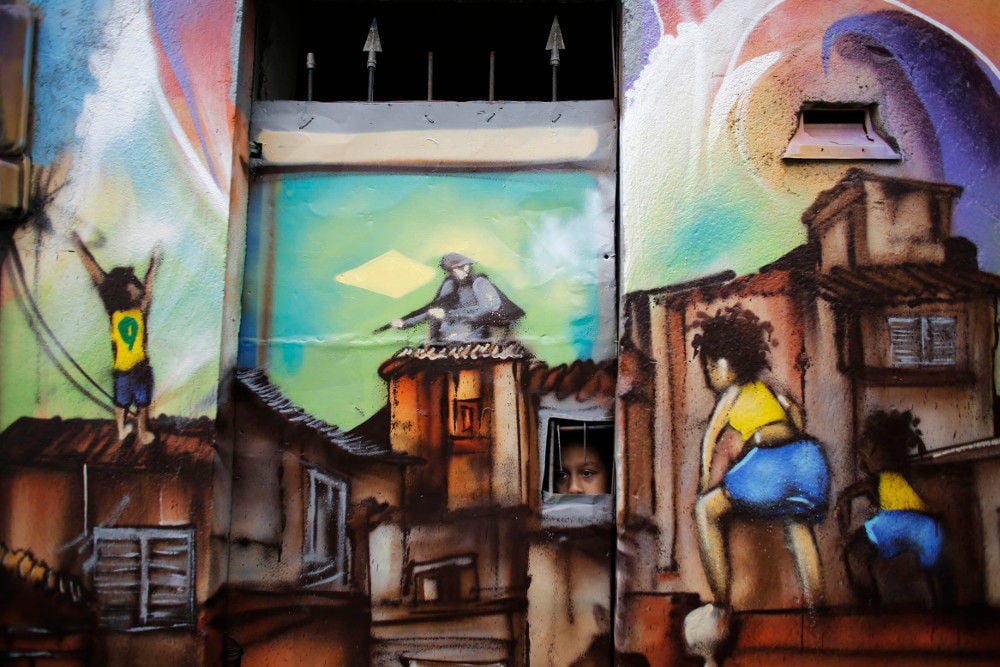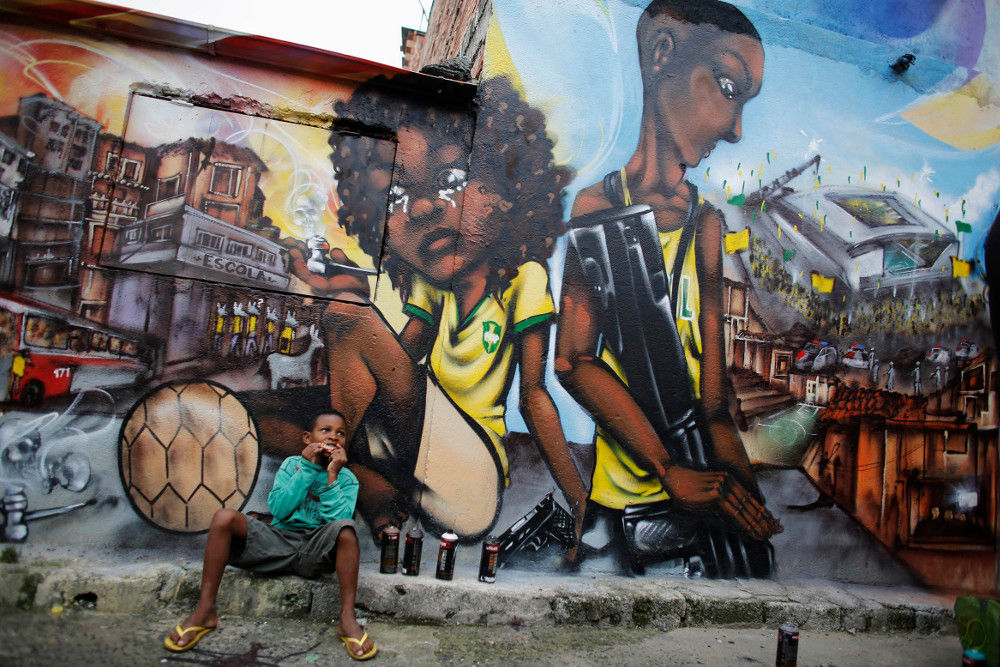Military police stand next to a mural of an Amazonian tribe member wearing a football jersey during a protest against the 2014 World Cup in São Paulo.
Seven thirty in the evening may not be the wisest time to hail a cab in São Paulo, Brazil. The streets are jammed, hooters honk continuously, and above the distinctive whir of helicopter blades scissor through the air as the well-heeled land atop the Emiliano hotel in upmarket Jardim.
When the cab pulls into the curved lane at Beco de Batman, or Batman Alley – the famous graffiti enclave in trendy Vila Madelena – the meter has ticked along considerably. As most locals, or Paulistanos, will tell you, two things count for much in this city – time and money.
To get an idea of what I should seek out in the street art and hip scene, I meet with a host of creatives – trend forecasters, two lawyers-turned-entrepreneurs, tour guides and street artists. Unsurprisingly, most of them operate in the online space. I take notes about bicycle street art tours (it’s notoriously difficult to bike during the week but the city has an open policy for bikers on Sundays), museums, food tours, markets and bars.
Just before we all hit the bistro, Flavia Liz Di Paolo, known to many as the best private tour guide in São Paulo, says openly: “Be glad you’re not here during the World Cup.”
We’ve been discussing the sentiment of anger at the coming games: the blame being pointed squarely at a corrupt government that has piddled away taxpayers’ money to build extra stadiums – among other ill-spent ventures – instead of focusing on desperately needed healthcare and education.
Mask of the city
As the conversation progresses, it’s apparent that the city wears a mask. Privilege and glamour permeate its streets, and yet the distribution of wealth is grossly disparate. But Di Paolo says: “Everyone, rich or poor – we’re furious about the World Cup. The country will shut down for a month; the kids won’t go to school.”
Street artist Paulo Ito created a piece depicting a hungry child crying opposite a large football; it went viral online. Later, by email he tells me: “I am always upset with how things work, or don’t, in Brazil. This is why I created it. Unlike fine art, street art is accessible to people. I think people can be motivated or moved by it. But how effective it is, I don’t know.”
Seated at the bistro, craft beers and plates of acarajé (a black bean dumpling deep-fried in palm oil) and coxinha (dome-shaped chicken croquettes) arrive at our table.
“The acarajé is a speciality from the northeast,” explains Carol Moré, a content curator from Follow the Colors blog, one of the country’s most popular image web sites.

Artist Paulo Ito with his work on the door of a public schoolhouse. (Photos: Reuters)
In a metropolitan as large and intimidating as São Paulo city with its 20-million inhabitants and well over 7.5-million cars, this group with varying backgrounds and differing skills form part of an intertwined friendship circle. To a great extent they’re interested in the same thing: improving life in São Paulo – its living conditions for the poor, its opportunities for artists and creators, its image to both Brazilians and the rest of the world.
“Seventy percent of Brazilians haven’t been to a local museum, and yet we are the second biggest population group to visit the Louvre in Paris. We must start believing in ourselves,” says Manuela Colombo, a former intellectual property lawyer who cofounded Conexão Cultural.
Local connection
The organisation aims to connect people with local culture, public spaces and artists. “Accomplishing meaningful work and changing perceptions from the inside and the outside has been my main goal with Conexão Cultural,” she explains.
The increasingly gentrified district of Vila Madelena, where we are dining, has fast become the home of young urbanites like Colombo. What was once crumbling and decrepit is now prospering with cafés selling ethically sourced coffee, boutiques, galleries and modern, remodelled apartment blocks. I can’t help but draw a reference to Maboneng or Woodstock, but on a far grander scale.
Batman Alley, a long twisting lane, and the surrounding streets covered in splashes of graffiti, lie mere metres away.

Graffiti by members of OPNI, a Portuguese acronym that means Unidentified Graffiti Artists, in the Vila Flavia slum of São Paulo.
Instagrafite documents global street art, including the pieces found in Batman Alley and all across the Cidade Cinza, or “grey city”, a reference made to São Paulo in the documentary about street art by the same name. Founders Marina Bortoluzzi and her husband Marcelo Pimentel hand out Instagrafite stickers to the table as well as iPhone covers and Moleskine diaries with the work of artist Speto (Paulo Silva), a project they curated.
I recognise Speto’s work from a mural I’ve seen at Mocotó, the award-winning bistro restaurant about an hour out of Jardim. It makes for compelling advertising, and both Bortoluzzi and Pimentel have a background spanning 10 years in the industry. What started out as a hobby three years ago is now the largest collaborative street art gallery in the world.
“We consider Instagrafite an independent media platform and we have almost a million followers,” says Bortoluzzi.
Instagrafite assists in allocating walls to local and visiting international artists. “They stay in our home. We find them a sponsor to pay them and they connect with local life.”
Street art app
Soon Markr, the intuitive application they are launching, will be available. It allows anyone to take a picture of graffiti with a smartphone and it will serve up the artist’s name.
In a city that has no visible outdoor advertising thanks to a “clean city law” passed in 2006, street art covers the urban substrates in mediums that have long surpassed tagging – the simple form of writing one’s name, usually associated with defacement and vandalism.
Intricate stencils (made famous by the reclusive British artist Banksy), spray painting, drawing with brushes, wheat-pasting and stickers are some forms of artistic expression found on the streets.

Graffiti in the Vila Flavia slum done by members of OPNI. (Reuters)
The enormous, complex murals that cover São Paulo are no overnight task, and the artists are often trained in some artistic medium. “My style comes from a diversity of experiences, from woodwork to my work as an art director. I’m influenced by geometric design, the city’s architecture, and I express this through animal figures,” says artist Arlin Cristiano of his brightly coloured linear pieces. (In person he is shy.)
São Paulo’s artists have learned the art of patience and persistence. Cidade Cinza reveals how the clean crews employed by city hall have the right to paint over whatever they deem “visual pollution”. In it Os Gêmeos, twin brothers and two of Brazil’s most famous artists narrate their story of frustration and challenge.
Distinctive design
Speto, who creates distinctive folk-art designs, commenced his career in 1985, at the end of the military dictatorship. He calls São Paulo an “unfair city”.
“It’s aggressive. We have no beach or landscape to distract people from routine. Graffiti brings colour and inspiration.”
It appears that, although the government has control over so many aspects, including outdoor advertising, the street artists of São Paulo have repossessed the city’s walls.
And the city has become an interlocutor to project their dreams and hopes, communicating directly with fellow Paulistanos, with whom the meaning of these works lie.
All you need to know
Stay: Emiliano, Hotel Unique, Casa Club Hostel.
Eat: Mocotó, Dalva e Dito, Mani.
Galleries: Galeria Nara Roesler, Choque Cultural, MASP.
Do: Street art tour: HEY! São Paulo, Food tour: Taste of São Paulo, General tour: Around São Paulo, Private tour: Flavia Liz.